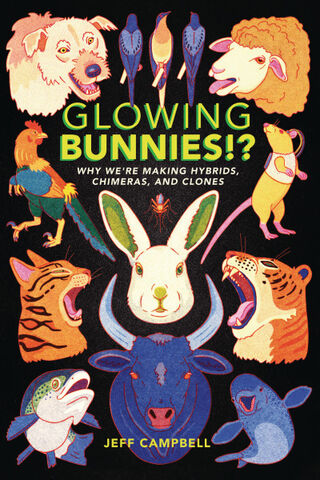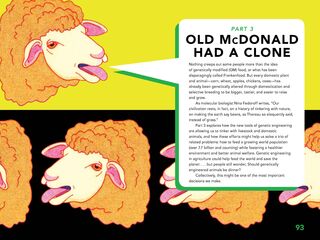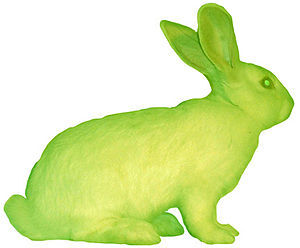UK becomes first to approve Casgevy genetic therapy for blood disorders
SOURCE: HTTPS://INTERESTINGENGINEERING.COM/
NOV 17, 2023
Should We Be Making Lilac Dogs and Glowing Bunnies?
SOURCE: PSYCHOLOGYTODAY.COM
JUL 28, 2022

When I read Jeff Campbell's thought-provoking, beautifully illustrated book Glowing Bunnies!?: Why We're Making Hybrids, Chimeras, and Clones, I couldn't put it down. In his riveting discussions of how we are bioengineering a wide variety of unnatural organisms, some call them monsters, my brain couldn't stop imagining future scenarios of what it all means—is it inherently "good" or "bad" or somewhere in between?
Jeff's important easy-to-read book vividly demonstrates why animal welfare must guide all our efforts with genetic engineering, whether for science, medicine, agriculture, or conservation. There are many important ethical questions that require us to dig deeply into why we are engaging in these experiments and who really benefits. These include the following: Are we making animal lives better when we fiddle with them or only our own lives? Are we acting with care, respect, and compassion? Are we moving too fast?
Glowing Bunnies!? understandably is receiving well-deserved accolades and is at once entertaining, thoughtful, and packed with information, and should be required reading not just for students but for everyone because genetic engineering might rapidly become business as usual.1

Source: Courtesy of Jeff Campbell, published by Zest Books
Here's what Jeff had to say about his well-referenced, wide-ranging, and in some ways frightening discussions of what we're doing and what it means to be manufacturing these living beings for our humancentric purposes.
Marc Bekoff: Why did you write Glowing Bunnies!?
Jeff Campbell: I stumbled onto the topic of animal bioengineering almost by accident, while writing my previous book, Last of the Giants, which profiles recently extinct and endangered animals. What I found is that for certain species—like aurochs, passenger pigeons, and woolly mammoths—extinction isn’t the end of the story anymore. Researchers are bringing all three species back from the dead, and there are more on the way, even possibly a dinosaur!
Turns out, science fiction isn’t fiction anymore, and as I explored genetic engineering further, I was truly blown away. I know it sounds like hyperbole, but to me, current gene editing technologies are equivalent to splitting the atom—bioengineering is that significant. We now have the ability to manipulate all life, anything with DNA, in almost any way we want. Yet as a society, we are only just starting to discuss what it is, what it can do, the best ways to use it, and most of all, whether we should. So I became very passionate about wanting to write a book that explores these questions.
In general, with my animal science books, I hope to inspire a sense of wonder and compassion for other species as well as a deep appreciation for how much we depend on animals. We need to care for animals for their own sakes, but also for ours and the planet’s sake, too. That has never been more true than with bioengineering.
MB: Who is your intended audience?
JC: The publishing category is young adult. My aim is to make bioengineering accessible to nonscientists, and I hope the book will appeal to readers from middle school through to adults. Glowing Bunnies!? isn’t about technology, per se, though I provide simple explanations of how gene editing works. It’s about bioethics. I want readers to ask, "Given what we can do, what should we do?" That’s a surprisingly complex question, with no single right answer, and I don’t try to provide answers. I want readers to consider animal bioengineering for themselves and come to their own conclusions.
MB: What are some of your major messages?
JC: There’s no way to cover all the potential uses in one book. So I focus on a handful of specific examples that relate to five areas: saving endangered species, environmental conservation (or deextinction and rewilding), agriculture and food, pets and products, and human medicine.

Source: Courtesy of Jeff Campbell, published by Zest Books
To be honest, I think maybe the most important question is whether, or how, to use bioengineered animals in agriculture and as food. There is a lot of fear over GMOs [genetically modified organisms], and that makes it very hard to talk about. But researching this book really opened my eyes to how positive bioengineering could be. It might help solve one of humanity’s biggest problems: how to feed our growing global population while using fewer resources and causing less harm to the planet. As you know, the impacts of agriculture can be devastating, on animals and nature, and yet we could create disease-resistant poultry, less-polluting pigs, and more-efficient cows, and even improve animal welfare. But that works only if people feel safe enough to consume [genetically modified] animal products like milk and eggs and to eat their meat.
Of course, every use, every animal, and every method raises different issues. It’s the same with bioengineering animals for medicine. There are thousands of potential applications. With so-called “farmaceuticals,” bioengineering is already creating life-saving medicine without harming animals. At other times, such as with xenotransplantation—or using bioengineered animal organs for human transplant—we have to decide if sacrificing animals is worth it. When I was researching Glowing Bunnies!?, that seemed like a far-off possibility, but, in January 2022, doctors successfully transplanted a modified pig heart into a human for the first time. The field is advancing very rapidly and forcing us to ask some very uncomfortable questions, like, "People eat pigs every day, but does that make it OK to engineer some so we can harvest their organs?"

Alba, a genetically modified glowing bunny.
Source: Wikimedia, ConitaMuñozBianchi, Creative Commons.
My main message is that we can’t be squeamish. This technology exists, and it’s poised to transform our world in all sorts of ways. So we need to consider what are wise and unwise uses.
MB: Are you hopeful that as people learn more about genetic engineering, they will be more willing to consider it?
JC: Absolutely. That was my experience writing the book. At first, I was anxious and a bit overwhelmed by the topic. Now, I have much less fear and more respect. Bioengineering is a tremendously powerful tool, that’s all. Like splitting the atom, whether it’s good or bad depends entirely on how we choose to use it.
References
In conversation with Jeff Campbell. Jeff has published two previous young adult books about animals: Daisy to the Rescue (a 2015 IPPY gold medal winner), about animals saving human lives and the science of animal intelligence, and Last of the Giants (a 2016 Junior Library Guild selection), about conservation and our current extinction crisis. Jeff was previously a travel writer for Lonely Planet and is also a book editor and writing teacher.
1. For example, in Kirkus Reviews, we read: "A controversial subject presented with verve that allows readers to make up their own minds." Publishers Weekly writes: “Thought-provoking. This enlightening work encourages readers to ask questions and conduct their own research, while maintaining that science continues evolving and changing faster than one can blink.”
Frankenstein's Cat: Biotechnology, Strange Creatures, and Us.
The State of the Art of Animal Welfare Science.

LATEST NEWS
WHAT'S TRENDING


Data Science
5 Imaginative Data Science Projects That Can Make Your Portfolio Stand Out
OCT 05, 2022

SOURCE: HTTPS://INTERESTINGENGINEERING.COM/
NOV 17, 2023
SOURCE: HTTPS://GENETICLITERACYPROJECT.ORG/
SEP 05, 2023
SOURCE: HTTPS://WWW.SCIENCEDAILY.COM/
AUG 07, 2023
SOURCE: HTTPS://WWW.SCIENCEDAILY.COM/
JUL 24, 2023
SOURCE: HTTPS://NEWS.MIT.EDU
JUL 20, 2023
SOURCE: BIOSPACE.COM
OCT 27, 2022